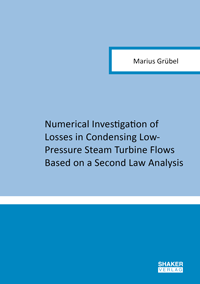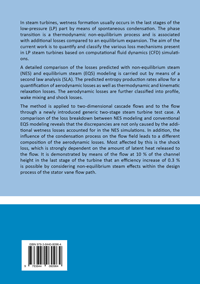
Shop : Details
Shop
Details
49,80 €ISBN 978-3-8440-8096-4Softcover216 pages85 figures321 g21 x 14,8 cmEnglishThesis
July 2021
Marius Grübel
Numerical Investigation of Losses in Condensing Low-Pressure Steam Turbine Flows Based on a Second Law Analysis
In steam turbines, wetness formation usually occurs in the last stages of the low-pressure (LP) part by means of spontaneous condensation. The phase transition is a thermodynamic non-equilibrium process and is associated with additional losses compared to an equilibrium expansion. The aim of the current work is to quantify and classify the various loss mechanisms present in LP steam turbines based on computational fluid dynamics (CFD) simulations.
A detailed comparison of the losses predicted with non-equilibrium steam (NES) and equilibrium steam (EQS) modeling is carried out by means of a second law analysis (SLA). The predicted entropy production rates allow for a quantification of aerodynamic losses as well as thermodynamic and kinematic relaxation losses. The aerodynamic losses are further classified into profile, wake mixing and shock losses. The method is applied to two-dimensional cascade flows and to the flow through a newly introduced generic two-stage steam turbine test case. A comparison of the loss breakdown between NES modeling and conventional EQS modeling reveals that the discrepancies are not only caused by the additional wetness losses accounted for in the NES simulations. In addition, the influence of the condensation process on the flow field leads to a different composition of the aerodynamic losses. Most affected by this is the shock loss, which is strongly dependent on the amount of latent heat released to the flow. It is demonstrated by means of the flow at 10 % of the channel height in the last stage of the turbine that an efficiency increase of 0.3 % is possible by considering non-equilibrium steam effects within the design process of the stator vane flow path.
A detailed comparison of the losses predicted with non-equilibrium steam (NES) and equilibrium steam (EQS) modeling is carried out by means of a second law analysis (SLA). The predicted entropy production rates allow for a quantification of aerodynamic losses as well as thermodynamic and kinematic relaxation losses. The aerodynamic losses are further classified into profile, wake mixing and shock losses. The method is applied to two-dimensional cascade flows and to the flow through a newly introduced generic two-stage steam turbine test case. A comparison of the loss breakdown between NES modeling and conventional EQS modeling reveals that the discrepancies are not only caused by the additional wetness losses accounted for in the NES simulations. In addition, the influence of the condensation process on the flow field leads to a different composition of the aerodynamic losses. Most affected by this is the shock loss, which is strongly dependent on the amount of latent heat released to the flow. It is demonstrated by means of the flow at 10 % of the channel height in the last stage of the turbine that an efficiency increase of 0.3 % is possible by considering non-equilibrium steam effects within the design process of the stator vane flow path.
Keywords: Computational Fluid Dynamics; Steam Turbine; Condensation; Entropy
Available online documents for this title
You need Adobe Reader, to view these files. Here you will find a little help and information for downloading the PDF files.
Please note that the online documents cannot be printed or edited.
Please also see further information at: Help and Information.
Please also see further information at: Help and Information.
| Document |  | Document | ||
| Type |  | |||
| Costs |  | 37,35 € | ||
| Action |  | Purchase in obligation and download the file | ||
| Document |  | Table of contents | ||
| Type |  | |||
| Costs |  | free | ||
| Action |  | Download the file | ||
User settings for registered online customers (online documents)
You can change your address details here and access documents you have already ordered.
User
Not logged in
Export of bibliographic data
Shaker Verlag GmbH
Am Langen Graben 15a
52353 Düren
Germany
Am Langen Graben 15a
52353 Düren
Germany
Mon. - Thurs. 8:00 a.m. to 4:00 p.m.
Fri. 8:00 a.m. to 3:00 p.m.
Fri. 8:00 a.m. to 3:00 p.m.
Contact us. We will be happy to help you.



